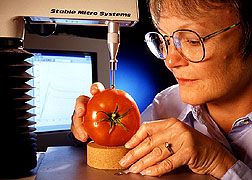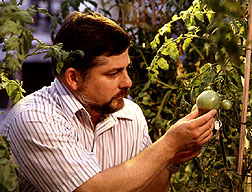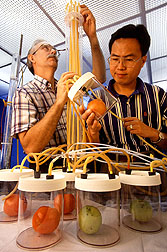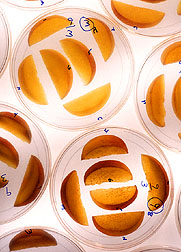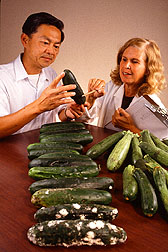Keeping Freshness in Fresh-Cut Produce
|
|
Juicy, sliced strawberries, diced beets, quartered tomatoes, slivered bell peppers, and chopped celery—nutritious, fresh-cut fruits and vegetables for salad bars and individual and family servings—are not just for restaurants. Nearly all major grocery chains are now carrying them. In great demand by health-conscious North Americans, fresh-cuts are also becoming more popular in Europe and Asia.
Sales of fresh-cut produce—a mushrooming industry—are expected to skyrocket to $19 billion by 1999. Packaged salads alone brought $889 million in 1995, with 8 out of 10 consumers surveyed buying them.
"Maintaining quality of fresh-cut and intact produce is a major concern of the industry and a top Agricultural Research Service priority," says Kenneth C. Gross. A plant physiologist, Gross heads the ARS Horticultural Crops Quality Laboratory (HCQL) in Beltsville, Maryland.
"Industry has been searching for alternative methods to protect fresh-cuts from decay and to prolong shelf life," he says. "Our scientists have discovered natural ways to reduce deterioration and decay and extend the shelf life of produce without the use of undesirable chemicals." [See "Fruit and Veggie Cut-Ups" in Agricultural Research, January 1997, pp. 20-21.]
Using Natural Compounds
Fresh fruits and vegetables, whether whole or cut up, must be kept at temperatures between 32oF and 50oF to reduce the chance of bacterial and fungal attack.
"Cool temperatures keep some harmful microorganisms at bay, but the cold can also cause injury," says Chien Yi Wang, a horticulturist at the HCQL. "Although the tissue is still living, it is weakened by an inability to carry on normal metabolic processes. And symptoms of chilling injury, such as pitting or other skin blemishes, become evident when the produce warms up."
|
|
Wang has successfully used many treatments to alleviate such damage. But his best success came when he found that sweet-smelling methyl jasmonate protected zucchini squash, sweet peppers, and grapefruit from chilling injury and doubled their shelf life.
"Jasmonates were first detected as fragrant compounds of essential oils in plants of the genus Jasminum," says Wang. "This group of natural compounds is found in all plants, but in significant amounts in jasmine and honeysuckle.
"We knew that many of the physiological responses to jasmonates are similar to the effects of abscisic acid," he says.
Levels of that plant hormone, which stimulates the natural separation of leaves and flowers from parent plants, increase when plants are subjected to environmental stress. "In several plant species, abscisic acid also increases protection against chilling injury," says Wang. "We thought that methyl jasmonate might induce a similar response."
Subsequent research with HCQL chemist J. George Buta showed that methyl jasmonate may reduce chilling injury by regulating levels of abscisic acid and polyamine compounds produced from amino acids that stabilize plant cells. Squash treated with methyl jasmonate showed no deterioration from cold-storage temperatures for up to 8 days, while untreated squash started to deteriorate after just 4 days.
How Does Methyl Jasmonate Work?
"Well, it's a fascinating compound," Buta says. "Chemically, it's associated with environmental stress. Apparently it's produced because of the stress and somehow serves as a signal, in the form of a chemical vapor, to turn on natural defense mechanisms."
Buta says that methyl jasmonate elicits compounds in living plants that make them more resistant to temperature changes and attack by insects, bacteria, and fungi. He thinks it turns on nucleic acid synthesis, which results in producing defense proteins. These proteins, in turn, cause the production of antifungal or antibacterial compounds. And methyl jasmonate elicits the same response in harvested produce, which is still-living tissue, as it does in growing plants.
Produced commercially, methyl jasmonate is relatively inexpensive, and only small amounts are needed to be effective.
"You can buy 25 milliliters—not quite an ounce—for about $30. This is enough to treat truckloads of produce. Also, it acts quickly—within a couple of hours after application," Buta reports, "and leaves no residue."
Produce should be treated at about room temperature (68oF). Application can be either by vapor or use of a wick in a closed container.
HCQL plant pathologist Harold E. Moline exposed strawberries to methyl jasmonate vapor for 24 hours at 68oF and controlled gray mold, Botrytis cinerea, a major fungal disease of postharvest fruits and vegetables, for up to 14 days in storage.
"Methyl jasmonate not only reduced the mold, but it enhanced the flavor of the strawberries as well," Moline says. "And treatment didn't affect the firmness of the fruit."
Refrigeration and modified atmospheres are now used to fight fungal decay of strawberries. But gray mold is still a problem with these methods.
Buta and Moline also treated fresh-cut celery and green peppers with methyl jasmonate vapor. Treatment eliminated browning and decreased bacterial growth a thousandfold on both products for up to 2 weeks at 50oF. It controlled soft rot on the peppers.
Buta and Moline have successfully used methyl jasmonate to slow down grey mold on grapes.
"Using too much could be detrimental and hasten deterioration," Buta cautions. "But if the right amount is used, under proper storage conditions, methyl jasmonate may be a practical treatment to ensure the safety of many fresh-cut and whole fruits and vegetables."
The scientists have been just as successful with other natural compounds. For example, a banana turns brown almost as soon as you cut it, making it one of the most difficult fresh-cut products to protect from deterioration. For this reason, bananas can't be used in salad bars.
But Buta and Moline have succeeded in keeping banana slices from browning for 2 weeks and have also reduced microbial growth.
"Using a mixture of citric acid and N-acetylcysteine—a common, sulphur-containing amino acid—we kept banana slices for 14 days at 40oF," Buta reports. "They didn't brown." This research finding allows bananas to be marketed as fresh-cut.
In other, preliminary studies, the treatment also kept fresh-cut slices of apple, pear, peach, plum, nectarine, and avocado from browning and reduced their decay. In fact, it worked better than the treatments that industry is now using. Treated apples held up well for as long as 50 days in cold storage, and in all cases, flavor was not affected.
But What About Texture?
An important aspect of the fresh-cut industry that, to date, has been given little research attention is that of texture—for both fresh-cut and intact produce.
"Texture is vitally important," says Judith A. Abbott, an HCQL horticulturist. "To test a tomato's firmness, we squeeze it. But we need a better guide to firmness if the fruit is intended for the fresh-cut market," she says.
"Fresh-cut produce must have a reasonable shelf life—time to move through the commercial distribution system. The time between when produce is cut and when it is consumed is very important. If not ripe enough, it won't taste good. But if the product is cut at too ripe a stage, then it will deteriorate even more rapidly."
Although tomatoes or cucumbers in the produce bin may have been pulled from the vine several days before purchase, they are still living and undergoing biological processes, such as ripening. Cutting them opens a Pandora's box. A cut is a wound: Wounds make produce ripen faster and increase its susceptibility to attack by pathogens.
All of these factors greatly affect produce texture.
Abbott is investigating the texture of fresh-cut tomato slices. She has used different types of probes and developed measuring methods with a force-deformation testing machine to test the firmness of different tomato varieties.
"The fruit needs to be firm enough to withstand mechanical handling. And commercial slicing machines literally throw a tomato against the slicing blades," Abbott says. "But once the tomato is sliced, it keeps changing. In fact, it continues to ripen right up to the moment you eat it."
The method now used to test whole tomato firmness can't be used for slices. Besides, the mechanical properties sensed by your hand when you squeeze a whole tomato and those sensed in your mouth when you eat it are quite different. Different methods are needed to evaluate the eating quality of tomato slices and wedges, as well as other cut produce.
With the fresh-cut industry growing at a rapid pace, volume of produce handled makes it impossible to hand slice. Therefore, the food industry needs varieties that can withstand a little rough handling but still end up with good eating texture.
Abbott and Gross are looking at different genetic lines for varieties that best suit the fresh-cut industry. Abbott is also reviewing different ways to sanitize and handle produce after it has been cut to ensure that texture is maintained. In addition to tomatoes, she is experimenting with whole and cut apples, cantaloupes, honeydews, and watermelons.
Manipulating Genes
|
|
Along with Gross, David Smith is taking a different approach to the texture issue. A molecular biologist at HCQL, Smith has just cloned part of a gene responsible for making a protein, which is an enzyme, that breaks down the cell wall in tomatoes. This cellular activity may cause some softening, which leads to texture changes that could end in deterioration and decay.
"There is a critical relationship between texture and quality and postharvest shelf life," Smith says. "And although other processes are involved in fruit softening, the breakdown of the structure of the cell wall is probably the most critical."
As tomatoes ripen, their cell walls go through several changes generated by many enzymes. According to Smith, these enzymes include a group called beta-galactosidases. He has identified and cloned a family of seven beta-galactosidase genes in tomatoes that includes the gene responsible for degrading cell wall structure.
"We're collaborating with two research groups in the United Kingdom to study the particular role of the gene involved in fruit softening," says Smith. "We're not sure just what the functions of the other genes are."
Smith is considering potential possibilities for using the cloned gene. "We can use the antisense approach, whereby we put the gene back in the opposite way it originally was, to knock out its function," he says.
"Or we can use co-suppression, in which we add back multiple copies of the gene that tells the plant to shut off all functions associated with these added genes. No one has figured out yet how this works; it just does."
According to lab director Gross, "We expect to have transgenic plants within a year." — By Doris Stanley,Agricultural Research Service Information staff, 128 Smallwood Village Center, Waldorf, MD 20602, phone (301) 893-6727.
Kenneth C. Gross and scientists mentioned in this article can be reached at the USDA-ARS Horticultural Crops Quality Laboratory, Bldg. 002, 10300 Baltimore Ave., Beltsville, MD 20705-2350; phone (301) 504-6128, fax (301) 504-5107.
"Keeping Freshness in Fresh-Cut Produce" was published in the February 1998 issue of Agricultural Research magazine. Click here to see this issue's table of contents.







